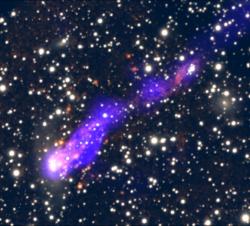A galaxy in the giant cluster but 3627 moves quickly within the cluster, leaving a "tail" of dust and gas where, surprisingly, new stars form

Pictured: the law of the galactic long tail
Astronomers have found evidence of star formation within a long tail of gas that stretches far beyond its parent galaxy. The discovery indicates that "orphan" stars are much more common than previously thought.
The photograph in which a comet-like body is seen, photographed in the X-ray field by NASA's Chandra Space Telescope and in the visible light field by the Southern Astrophysical Research Institute (SOAR) telescope in Chile. The "comet" is over 200 light-years long and was formed when gas was torn from a galaxy known as ESO 137-001 that plunges into the center of the Abel 3627 cluster - which is a huge star cluster.
"This is the longest tail-like configuration we've ever seen," says Ming Sun of Michigan State University, who led the study. And it seems that precisely in this tail there is a lot of activity of creating new stars and not of destruction."
The observations indicate that gas in the tail is used to form millions of stars. Due to the large amount of gas and dust required to form stars, this process occurs mostly inside galaxies, and astronomers believed that it was unlikely that large numbers of stars would form outside galaxies. "This is not the first time we have seen stars forming between galaxies," says team member Megan Donio, also from MSU. "But the number of stars formed here is enormous."
The stars are formed in 29 regions of ionized hydrogen gas that glow in visible light (pictured). These regions are located down the galaxy, right next to or inside the tail. Two X-ray sources measured by Chandra are also in the same region, further evidence of star-forming activity. The researchers believe that these orphan stars were formed in the last 10 million years that we are able to see (the galaxy is about 220 million light years from Earth).
These are many thousands of stars, but they are isolated from the rest of the stars in the galaxy and by the standards of galaxies, these are single stars, says Mark Witt, another member of the team. "If life forms on a planet in this group in a few billion years, it will see a very dark sky."
The research will be published in the December 10 issue of the Astrophysical Journal.
For information on the NASA website
